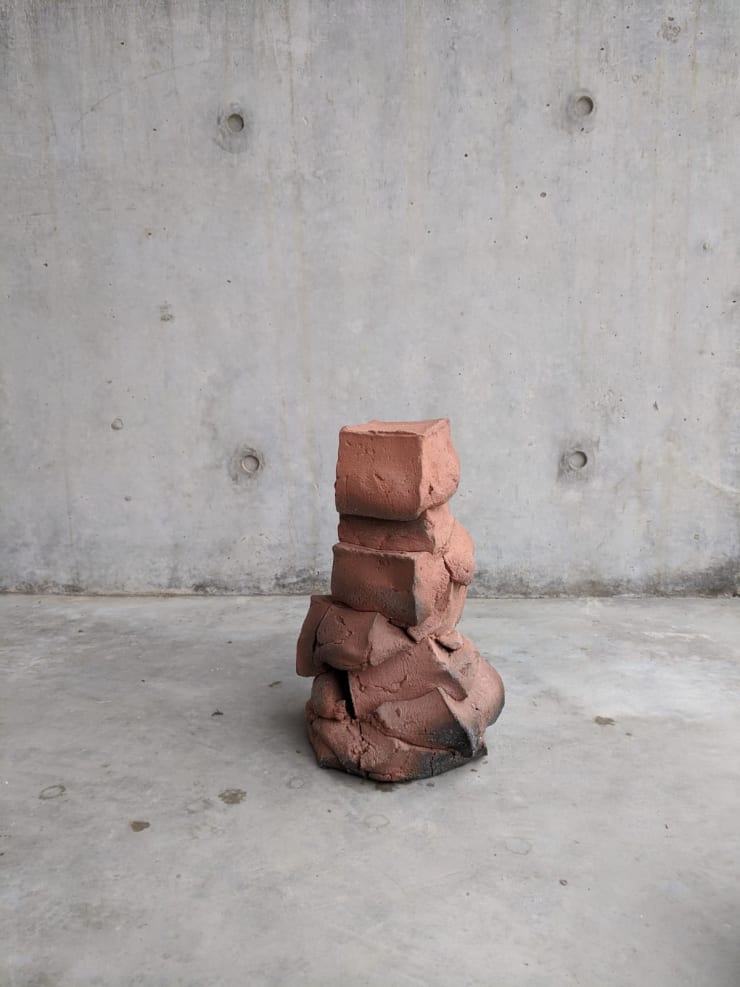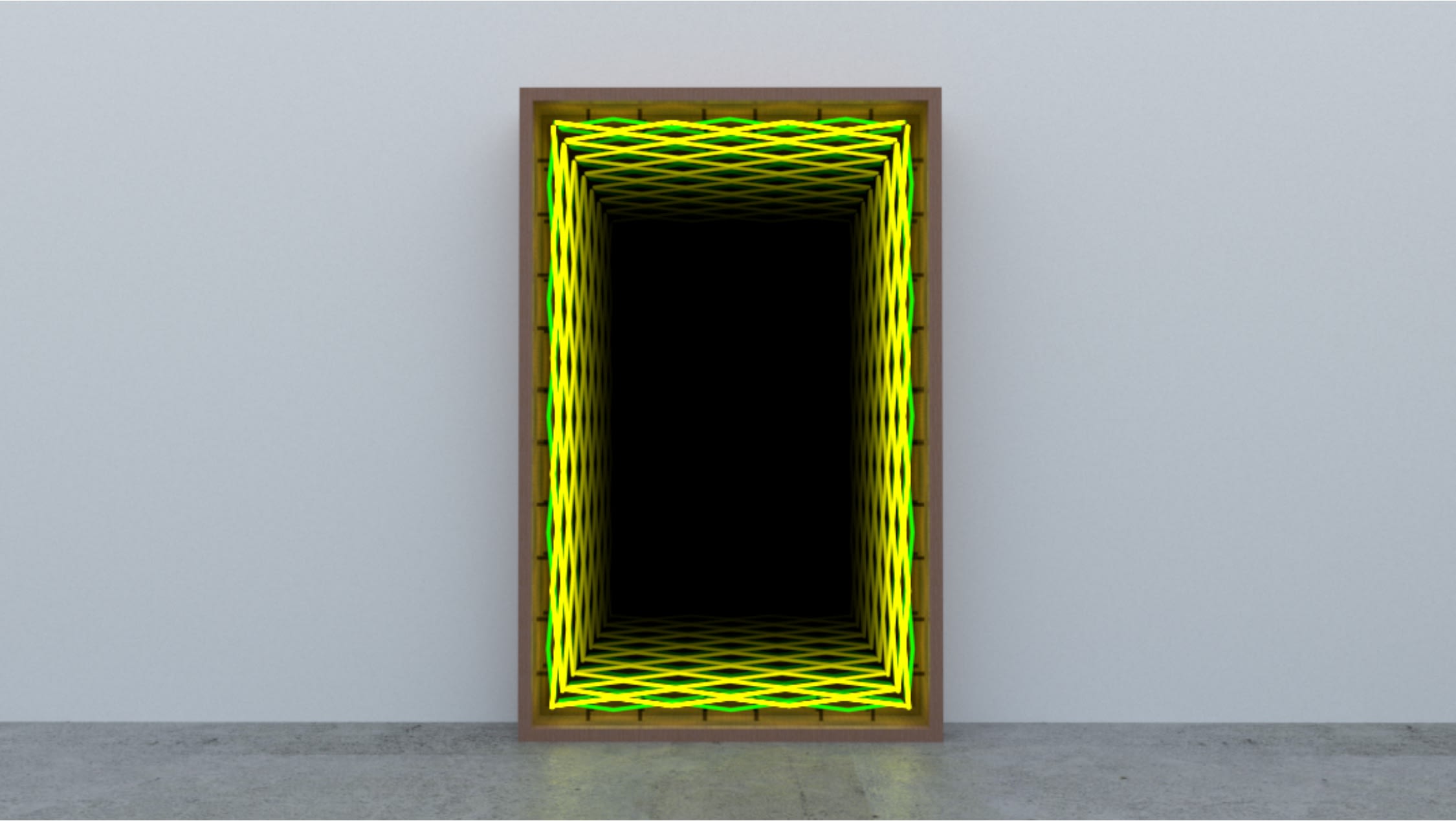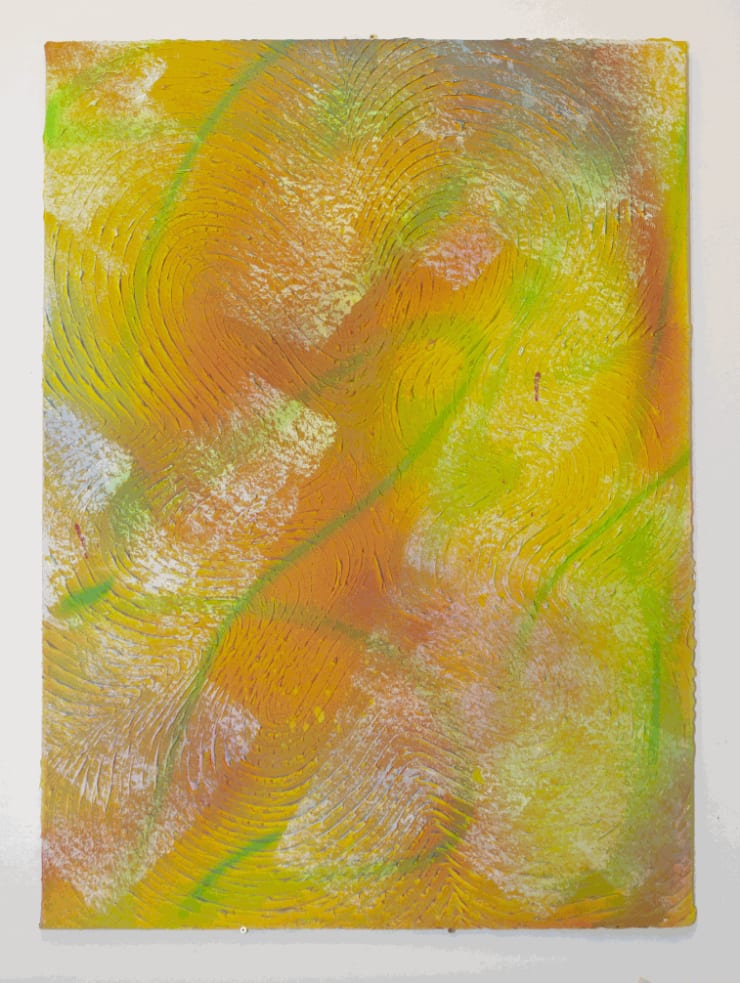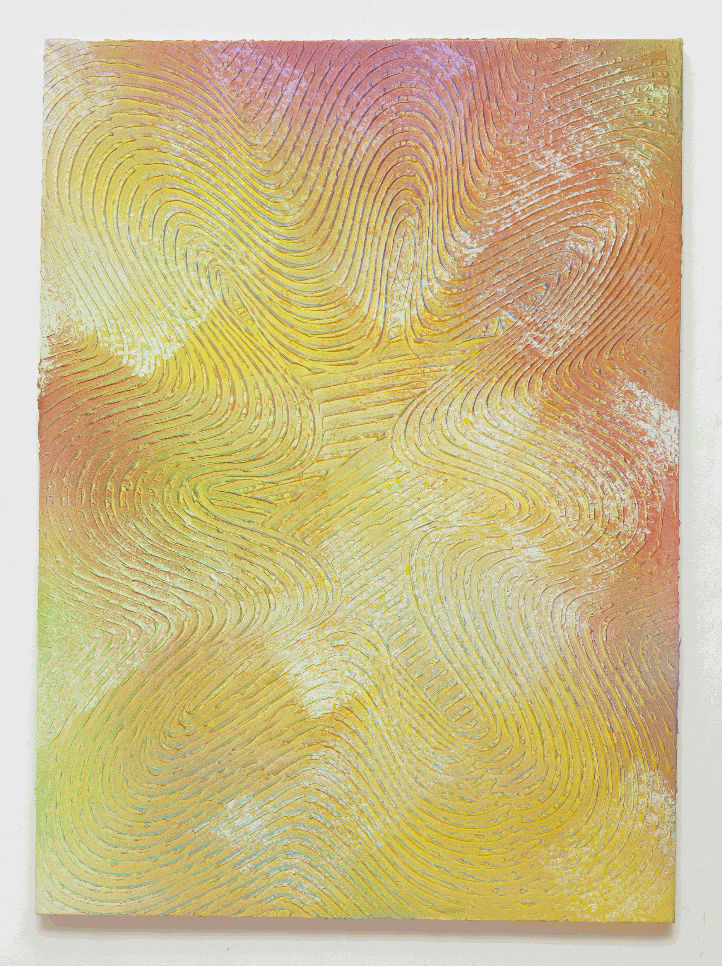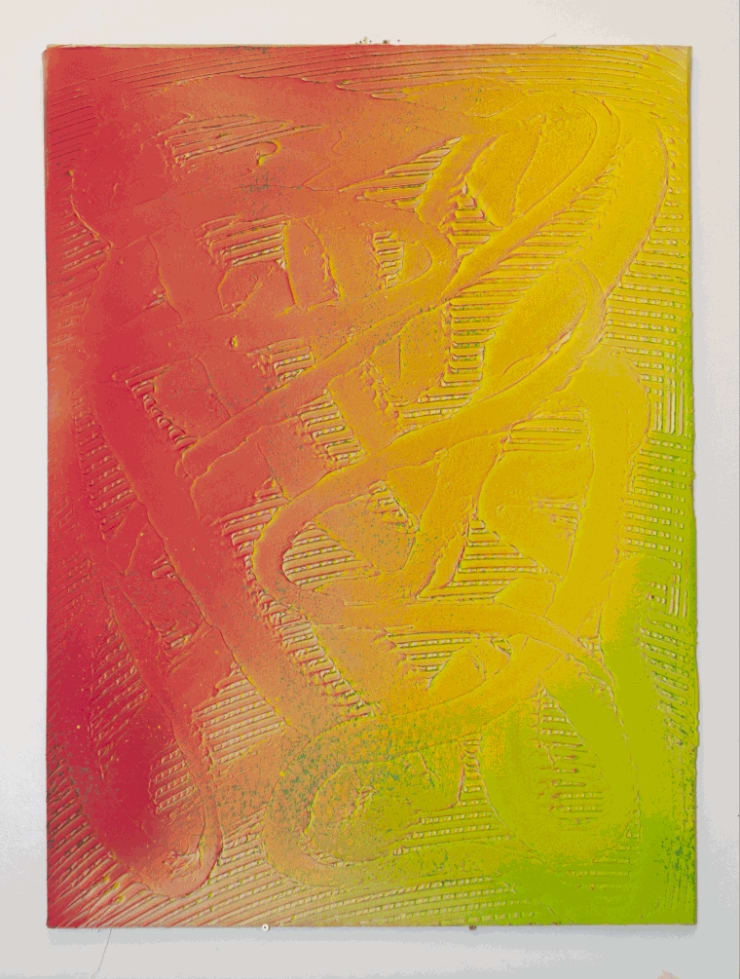-
Art Basel OVR: Miami Beach: Reflexiones
-
Para essa edição online da Art Basel, a Luciana Brito Galeria tem o prazer de apresentar um conjunto de trabalhos dos artistas Bosco Sodi (1970, México), Caio Reisewitz (1967, Brasil), Hector Zamora (1974, México), Ivan Navarro (1972, Chile), Jorge Pardo (1963, Cuba), Regina Silveira (1939, Brasil) e Tiago Tebet (1986, Brasil). Trata-se de uma produção inédita que de alguma forma relaciona-se a questões pertinentes às problemáticas enfrentadas ao longo do ano.
"Dreamer II" (2020), de Regina Silveira, foi concebida durante o isolamento social. Enquanto o título remete ao estado empírico do momento, a obra traz um conceito recorrente da artista, que mais uma vez combina a forma de expressão mais primitiva do ser humano, as mãos, com objetos utilitários do cotidiano. Depois de um longo período fechado para o público, o Metropolitan Museum of Art (NY) recentemente inaugurou "Lattice Detour", instalação que inspirou o novo vídeo "Photokinetic" (2020), de Hector Zamora. Aqui, parte do grande muro concebido pelo artista no terraço do museu traz sombras de pessoas que mesclam com os blocos vazados de terracota, quebrando a rigidez dessa grande barreira.
Esse ano também rendeu grandes discussões em torno da exploração e devastação das florestas brasileiras. Caio Reisewitz apresenta "Airuaca" (2020), um trabalho de sobreposição de imagens da icônica arquitetura da capital Brasília e da mata verde brasileira, reforçando a responsabilidade política em torno dos grandes desastres naturais atualmente vividos pelo Brasil. Da mesma forma o artista cubano Jorge Pardo apresenta "Brazil" (2020), uma série de pinturas, resultado de um trabalho repleto de camadas de processo de produção, inspiradas na natureza Brasileira, numa reverência a exuberância e importância da mata nativa. Já Bosco Sodi, traz uma de suas pinturas tradicionais monocromáticas, "Sem título" (2020), cuja técnica por si só é carregada de conceitos que resgatam os valores da natureza e ancestralidade, por agregar pigmentos e fibras naturais que criam verdadeiros efeitos geológicos.
Ainda no âmbito das pinturas, Tiago Tebet apresenta alguns de seus trabalhos mais recentes. Nesta série de trabalhos, o artista prioriza os métodos mecânicos e artesanais para atingir efeitos espontâneos e promover uma maior variação de linguagens dentro da sua pesquisa, voltando-se para os aspectos informais da construção pictórica e materialidade. Ivan Navarro, por sua vez, apresenta alguns trabalhos das suas tão icônicas séries de "caixas luminosas", que lembram portais de luz com dimensão suficiente para adentrar uma pessoa. Uma prática muito usada pelo artista é o uso da desconstrução de símbolos de ideologias e elementos comuns para a transmissão de mensagens políticas e sociais. Crescido sob o regime ditatorial do governo Pinochet, no Chile, o artista entendeu como o uso de códigos e mensagens subliminares podem combater o poder institucionalizado em favor dos direitos humanos.
For this online edition of Art Basel, Luciana Brito Galeria is pleased to present a selection of works by the artists Bosco Sodi (1970, Mexico), Caio Reisewitz (1967, Brazil), Hector Zamora (1974, Mexico), Ivan Navarro (1972, Chile), Jorge Pardo (1963, Cuba) Regina Silveira (1939, Brazil) and Tiago Tebet (1986, Brasil). This is a brand-new production which in some way deals with questions pertaining to the problematics the world has faced over the course of this year.
Dreamer II (2020), by Regina Silveira, was conceived during social isolation. While the title refers to the empirical state of the moment, the work features one of the artist's recurring concepts, once again combining the human being's most primitive form of expression - the hands - with utilitarian objects of everyday life. After a long time closed to the public, the Metropolitan Museum of Art (NY) recently inaugurated Lattice Detour, an installation that inspired the new video Photokinetic (2020), by Hector Zamora. Here, part of the large curving wall conceived by the artist on the museum's terrace presents shadows of people blended with its terracotta breeze blocks, breaking the rigidity of this barrier.
This year also saw the rise of intense discussion concerning the exploitation and devastation of Brazilian forests. Caio Reisewitz presents Airuaca (2020), a work in which portraits of iconic architectural works in Brazil's federal capital, Brasília, are overlaid to images of green Brazilian forests, underscoring the political responsibility behind the large natural disasters that are currently besetting Brazil. In a similar vein, Cuban artist Jorge Pardo presents Brasil [Brazil] (2020), a series of paintings, resulting from a work full of layers of the production process, inspired by Brazilian nature, in an homage to the exuberance and importance of the native forests. For his part, Bosco Sodi, is presenting one of his traditional monochromatic paintings, Sem título [Untitled] (2020), whose very technique is charged with concepts that recover the values of nature and ancestrality, by using natural fibers and pigments that create true geological effects.
Also in the context of paintings, Tiago Tebet is presenting some of his more recent artworks. In this series of works, the artist prioritizes mechanical and artisanal methods to achieve spontaneous effects and to promote a wider variation of languages within his research, focusing on the informal aspects of pictorial construction and materiality. For his part, Ivan Navarro is presenting some works from his very iconic series of "light boxes," which recall portals of light large enough for a person to enter. In his practice, the artist often recurs to the deconstruction of symbols of ideologies and common elements for the transmission of political and social messages. While growing up under the Pinochet dictatorship in Chile, the artist came to understand how the use of subliminal messages and codes can combat institutionalized power in favor of human rights.
-

BOSCO SODI
SEM TÍTULO | UNTITLED, 2020
técnica mista sobre tela | mixed media on canvas
140 x 180 cm | 55.12 x 70.87 in -
Bosco Sodi
1970 Mexico City, Mexico Lives and works in New York, USA and Puerto Escondido, MexicoReconhecido por obras monocromáticas de grandes dimensões, Bosco Sodi trabalha a pintura com uma combinação de pigmentos naturais, serragem, fibras naturais e cola. À medida que este composto seca, rachaduras surgem criando um efeito que remete aos fenômenos geológicos e químicos. Cada pintura é executada em um processo ininterrupto, como numa performance. Sodi trabalha ainda com esculturas e instalações que dialogam com a Land Art, resgatando sua ancestralidade nativo-americana.
Dentre as suas exposições individuais estão: Museo Barracco di Scultura Antica, Roma (2019), Museo Naional de Arte, México (2017), The Bronx Museum, Nova York (2010). Mostras coletivas: Harbour Arts Sculpture Park, Hong Kong (2018), The Museum of Modern Art, Gunma, Japão (2017) e Museo Espacio, México (2016), etc.
Recognized for his large-format monochromatic works, Bosco Sodi produces paintings with a combination of natural pigments, sawdust, natural fibers and glue. As this combination dries, cracks form to create an effect that resembles geological and chemical phenomena. Each painting is executed in an uninterrupted process, like a performance. Sodi also works with sculptures and installations that dialogue with land art, recovering his native American ancestry.
Venues that have hosted his solo shows include the Bronx Museum, New York (2010); the Museo National de Arte, Mexico (2017); and the Museo Barracco di Scultura Antica, Rome (2019). Those of his participations in group shows include the Museo Espacio, Mexico (2016), the Museum of Modern Art, Gunma, Japan (2017); and the Harbour Arts Sculpture Park, Hong Kong (2018).
-

CAIO REISEWITZ
UPURUPÃ, 2020
c-print em metacrilato | c-print mounted on Diasec
120 x 180 cm | 47.24 x 70.87 in
Edição 1/5 -
Caio Reisewitz
1967 São Paulo, Brazil Lives and works in São Paulo, BrazilA pesquisa de Caio Reisewitz traz a fotografia como suporte principal. Suas composições demostram um interesse pela ação do homem e seus efeitos sociais e políticos, seja no espaço natural, seja no arquitetónico, ao passo que o refinamento técnico exalta a dramaticidade entre luz, sombra, cores e texturas.
Caio Reisewitz é formado em artes, com especialização em poéticas visuais. Dentre as exposições individuais, estão: Pinacoteca do Estado de São Paulo (2017), Maison Europeénne de la Photographie, Paris (2015) e ICP – International Center of Photography, NY, (2014). Dentre as mostras coletivas estão: 26ª Bienal de São Paulo (2004), 51ª Biennale di Venezia (2005) e Nanjin Biennale (2010), MUSAC – Museo de Arte Contemporáneo de Castilla e León, León (2010) e Instituto Moreira Salles Rio de Janeiro (2010).
In his research, Caio Reisewitz uses photography as his main medium. His compositions demonstrate an interest in human action and its physical and social effects in either the natural or the architectural space, coupled with technical refinement that enhances the drama among the areas of light, shadow, colors and textures.
Caio Reisewitz holds a degree in the arts, with a specialization in visual poetics. He has held solo shows at venues that include the International Center of Photography (ICP), NY, (2014); the Maison Europeénne de la Photographie, Paris (2015); and the Pinacoteca do Estado de São Paulo (2017). Venues where he has participated in group shows include the 26th Bienal de São Paulo (2004); the 51st Venice Biennale (2005); the Nanjin Biennale (2010); the Museo de Arte Contemporáneo de Castilla e León (MUSAC), León (2010); and Instituto Moreira Salles Rio de Janeiro (2010).
-

CAIO REISEWITZ
AIRUACA, 2020
c-print em metacrilato | c-print mounted on Diasec
120 x 203 cm | 47.24 x 90.55 in
Edição 1/5 -
HÉCTOR ZAMORA
PHOTOKINETIC, 2020
Video 4K
Duração: 04'48" | duration: 04'48"Edition 1/3
-
HÉCTOR ZAMORA
1974, Mexico City, Mexico. Lives and works in Lisbon, Portugal.A obra de Héctor Zamora problematiza questões históricas, sociais e políticas relacionadas a sociedade contemporânea. Seus trabalhos conciliam opostos e criam um estranhamento crítico capaz de deslocar significados e entendimentos. Geralmente subverte os espaços arquitetônicos, redefinindo e resignificando o convencional.
Héctor Zamora tem formação em design gráfico e geometria estrutural. Suas principais mostras individuais: Pavilhão Branco (Lisboa, 2018), Palais de Tokyo (Paris, 2016), CCBB São Paulo (2016) e Itaú Cultural (São Paulo, 2010). Dentre as coletivas, estão: 53ª Bienal de Veneza; 11ª e a 14ª Bienal de Lyon (2011 e 2017); 9ª e 12ª Bienal de la Habana (2006 e 2015); 27ª Bienal de São Paulo (2006). Atualmente, Zamora apresenta a instalação “Lattice Detour”, no Metropolitan Museum - NY.
Héctor Zamora’s work problematizes historical, social and political questions related to contemporary society. His works reconcile opposites and create a critical estrangement able to displace meanings and understandings. He generally subverts the architectural spaces, redefining and re-signifying the conventional.
Héctor Zamora studied graphic design and structural geometry. Venues that have hosted his solo shows most notably include Itaú Cultural (São Paulo, 2010); the Centro Cultural Banco do Brasil (CCBB), São Paulo (2016); the Palais de Tokyo, Paris (2016); and the Pavilhão Branco, Lisbon (2018). Venues of group shows in which he participated include the 27th Bienal de São Paulo (2006); the 9th and 12th editions of the Bienal de Havana (2006 and 2015); the 53rd Venice Biennale (2009); and the 11th and 14th editions of the Bienal de Lyon (2011 and 2017). Currently, Zamora is presenting the installation Lattice Detour at the Metropolitan Museum of New York.
-

IVÁN NAVARRO
DIAMANTE YELLOW-GREEN, 2020
neon, espelho, caixa de madeira e energia | neon, mirror, one-way mirror, wooden box and electric energy
200 x 130 x 27,5 cm | 78.74 x 51.18 x 10.83 in -
Iván Navarro
1972 Santiago, Chile Lives and works in New York, USA.A produção de Iván Navarro baseia-se principalmente no diálogo entre as histórias da arte e da política. Sob o ponto de vista formal, seus trabalhos reúnem referências do Minimalismo, especialmente por meio do uso da luz, além de reunirem conotações políticas, que são comunicadas ao público estrategicamente, seja por meio dos títulos, cores ou mesmo na apropriação e desconstrução de símbolos.
Iván Navarro formou-se em Artes Visuais. Dentre as mostras individuais estão: MAC – Niteroi, RJ (2019), MACBA, Buenos Aires (2019), Museu Nacional de Belas Artes, Santiago, Chile (2015), Espace Culturel Louis Vuitton, Paris, França (2010). Dentre as coletivas: 13o Bienal do Cairo (2019), Museo del Barrio, NY (2017), MuBE-SP (2016), Guggenheim NY (2018), 53a Biennale di Venezia (2009), 2a Bienal de Moscou (2007), etc.
Iván Navarro’s production is based mainly on the dialogue between the histories of art and politics. From a formal point of view, his works combine references from minimalism, especially through the use of light, as well as political connotations, which are communicated to the observer strategically, through titles, colors or even the appropriation and deconstruction of symbols.
Iván Navarro holds a degree in visual arts. Venues that have hosted his solo shows include the Espace Culturel Louis Vuitton, Paris (2010); the Museu Nacional de Belas Artes, Santiago (2015); MACBA, Buenos Aires (2019), and the Museu de Arte Contemporânea de Niterói (MAC Niterói) (2019). He has participated in group shows at venues that include the 2nd Moscow Biennial (2007); the 53rd Venice Biennale (2009); Guggenheim Museum, New York (2014); the Museu Brasileiro da Escultura e Ecologia (MuBE), São Paulo, (2016); the Museo del Barrio, New York (2017); and 13th Bienal do Cairo (2019).
-

IVÁN NAVARRO
LADRILLO VERTICAL NORMAL BLUE, 2020
neon, espelho, caixa de madeira e energia | neon, mirror, one-way mirror, wooden box and electric energy
218,4 x 99,31 x 20 cm | 85.98 x 39.09 x 7.87 in
-

JORGE PARDO
BRAZIL 1 UNTITLED, 2020
acrílica sobre MDF gravado, compensado de bétula, revestimento e luminárias led
acrylic on engraved MDF, birch plywood, veneer, led fixtures
200 x 240 x 7 cm | 78.74 x 94.84 x 2.75 in
-
Jorge Pardo
1963, Havana, Cuba. Lives and works between Merida, Mexico and USA.A investigação de Jorge Pardo aborda o conceito de funcionalidade, especialmente quando beira o absurdo e a pureza do objeto, questionando os limites da arte. Sua pesquisa evolui numa narrativa construtiva, como por exemplo a justaposição de técnicas diversas para compor um conjunto pictórico de referências não apenas da contemporaneidade, mas que também adentram o universo da própria história da arte.
O artista formou-se em belas-artes. Dentre as exposições individuais estão as realizadas na Pinacoteca do Estado de São Paulo (2019), Petzel Gallery, Nova York (2014), Gagosian Gallery, Nova York (2010), Irish Museum of Modern Art, Dublin (2010), Los Angeles County Museum of Art (2008), e Museum of Contemporary Art, Miami (2007). Dentre as mostras coletivas está a 57ª Bienal de Veneza (2017).
Jorge Pardo’s investigation deals with the concept of functionality, especially when it borders on the absurd and the purity of the object, questioning the limits of art. He develops his research within a constructive narrative, as for example the juxtaposition of various techniques to compose a pictorial set of references from both contemporary contexts as well as art history.
He holds a degree in fine arts. Venues that have hosted his solo shows include the Museum of Contemporary Art, Miami (2007); the Los Angeles County Museum of Art (2008); the Irish Museum of Modern Art, Dublin (2010); Gagosian Gallery, New York (2010); Petzel Gallery, New York (2014); and the Pinacoteca do Estado de São Paulo (2019). He has participated in various group shows, including the 57th Venice Biennale (2017).
-

JORGE PARDO
BRAZIL 6 UNTITLED, 2020acrílica sobre MDF gravado, compensado de bétula, revestimento e luminárias led
acrylic on engraved MDF, birch plywood, veneer, led fixtures
165 x 240 x 7 cm | 64.96 x 94.48 x 2.75 in -

JORGE PARDO
SEM TÍTULO, ESFERA 4 | UNTITLED, SPHERE 4, 2019
PETG colorido 2mm, base de alumínio, acessórios de alumínio
Colored PETG 2mm, aluminum base, aluminum fixtures, electrical fixtures
57 x 70 (diam) cm | 22.44 x 27.55 (diam) in -

JORGE PARDO
SEM TÍTULO, LONGO 3 | UNTITLED, LONG 3, 2019
PETG colorido 2mm, base de alumínio, acessórios de alumínio
Colored PETG 2mm, aluminum base, aluminum fixtures, electrical fixtures
80 x 60 (diam) cm | 31.49 x 23.62 (diam) in -

REGINA SILVEIRA
DREAMER II, 2020
decalques sobre-vidrados em vidro jateado e madeira | overglaze decals on sandblasted glass and wood
41,5 x 59 x 59 cm | 16.33 x 23.22 x 23.22 in -
Regina Silveira
1939, Porto Alegre, Brasil. Vive e trabalha em São Paulo, Brasil.Ao longo de mais de quatro décadas, Silveira, uma figura crítica na arte conceitual brasileira, investigou a tensão entre movimento e perspectiva espacial, inserindo significado político em instalações que respondem a locais específicos. Nos anos 50, iniciou sua formação artística sob a tutela do pintor expressionista Iberê Camargo, estudando litografia e xilogravura, além de pintura. Reconhecida por suas explorações paródicas do espaço através de construções geométricas, a obra de Silveira é celebrada tanto pelo rigor conceitual quanto pelo impacto formal.
Bacharel em Artes pelo Instituto de Artes do Rio Grande do Sul (1959), Mestre (1980) e Doutora em Arte (1984) pela Escola de Comunicações e Artes da Universidade de São Paulo, sua carreira docente inclui o ensino no Instituto de Artes do Rio Grande do Sul (1964 a 1969); na Universidade de Puerto Rico, em Mayaguez (1964 a 1973 ); na Faculdade Armando Alvares Penteado, São Paulo (1973 a 1985) ; e na ECA USP, de 1974 ao presente. Artista convidada da Bienal de São Paulo em 1981, 1983, 1998, da Bienal Internacional de Curitiba em 2013 e 2015 e da Bienal do Mercosul em 2001, 2011. Participou da Bienal de La Habana, Cuba, em 1986, 1998 e 2015; Médiations Biennale, Poznan, Polônia, em 2012; 6th Taipei Biennial, Taiwan, em 2006; e 2nd Setouchi Triennale, Japão, em 2016.
Throughout more than four decades, Silveira, a critical figure in Brazilian conceptual art, has investigated the tension between movement and spatial perspective, threading political meaning into installations that respond to specific sites. In the 1950s she began her artistic training under the tutelage of expressionist painter Iberê Camargo, studying lithography and woodcut, as well as painting. Renowned for her parodic explorations of space through geometric constructs, Silveiraʼs work is celebrated for both its conceptual rigor and formal impact.
Graduated in Fine Arts by Instituto de Artes da UFRGS (1959); Master’s degree (1980) and Ph.D. (1984) at Escola de Comunicação e Artes at USP – Universidade de São Paulo, Brazil. Professor at Instituto de Artes of UFRGS (1964-69), Universidad de Puerto Rico, Campus de Mayaguez (1969-1973), FAAP – Fundação Armando Alvares Penteado, São Paulo (1973-85) and Escola de Comunicação e Artes, USP, since 1974.
The artist took part in several biennials, such as Bienal de São Paulo (1981, 1983, 1998), Bienal Internacional de Curitiba (2013 e 2015) Bienal do Mercosul (2001, 2011), Brazil; Bienal de La Habana, Cuba (1986, 1998 e 2015); Médiations Biennale, Poznan, Poland (2012); 6th Taipei Biennial, Taiwan, (2006); 2nd Setouchi Triennale, Japan (2016). recente Some of her most recent group exhibitions: “O Poder da Multiplicação”, MARGS, Porto Alegre, Brazil, 2018; “Die Macht der Vervielfältigung”, Leipziger Baumwollspinnerei, Leipzig, Germany 2019; “Mixed Realities”, Kunst Museum, Stuttgart, Germany, 2018; “Imprint”, Academy of Fine Arts, Warsaw, Poland, 2017; “Future Shock”, Site Santa Fe, Santa Fe, USA, 2017; “Radical Women in Latin America”, Hammer Museum, Los Angeles, USA, 2017; “Consciência Cibernética (?)”, Itaú Cultural, São Paulo, Brazil, 2017.
-

TIAGO TEBET
SEM TÍTULO | UNTITLED #121, 2019
massa acrílica e acrílica sobre tela | plaster and acrylic on canvas
110 x 80 cm | 43.30 x 31.49 in -
Tiago Tebet
1986 São Paulo, Brazil Lives and Works in São Paulo, BrazilA pintura como linguagem é o principal objeto de pesquisa de Tiago Tebet. Associada a uma habilidade técnica impecável, sua investigação recai sobre as possibilidades e especificidades da representação, explorando seus processos e formas de resignificação. A representatividade da contracultura de práticas marginalizadas é uma das temáticas que mais o atrai.
Tiago Tebet é formado em Artes. Dentre suas exposições individuais estão: Luciana Brito Galeria (2011, 2013 e 2020), Lisa Kandlhofer Galerie, Viena, Austria (2018) e Sim Galeria (2012). As principais coletivas: Instituto Tomie Ohtake (2017), 10a Bienal do Mercosul (2015) e Paralela (2010).
Painting as a language is Tiago Tebet’s principal subject of research. Using impeccable technical ability, he investigates the possibilities and specificities of representation, exploring their processes and forms of re-signification. One of the themes that most attracts him is the representativity of the counterculture of marginalized practices.
Tiago Tebet holds a degree in the arts. Venues that have hosted his solo shows include Luciana Brito Galeria, São Paulo (2011, 2013 and 2020); Lisa Kandlhofer Galerie, Vienna, Austria (2018); and Sim Galeria, Curitiba (2012). He has participated in group shows at venues that include Paralela, at the Liceu de Artes e Ofícios, São Paulo (2010); the 10th Bienal do Mercosul, Porto Alegre (2015), and Instituto Tomie Ohtake, São Paulo (2017).
-






